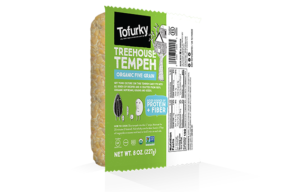Tempeh

By Reed Mangels, PhD, RD
Tempeh (also known as tempe) is a traditional fermented product that originated in Indonesia. It is made by hulling, soaking, and partially cooking whole soybeans or other legumes, grains, or seeds. The beans are then inoculated with a tempeh starter (most commonly rhizopus spores) and incubated. The final product, tempeh, is a solid cake that has a mat of white mycelium (fine filaments) holding together the beans, grains, or seeds. Tempeh’s taste has been described as “nutty,” “cheesy,” “yeasty,” or “like mushrooms.”
Commercial varieties of tempeh, in addition to soy tempeh include Tofurky’s Five Grain Tempeh made with soybeans, brown rice, sesame seeds, sunflower seeds and millet; Lightlife’s Three Grain Tempeh made with soybeans, brown rice, barley, and millet; and SoyBoy’s Five Grain Tempeh made with soybeans, brown rice, millet, kasha, and quinoa. Soy-free tempeh products include those made with azuki beans, chickpeas, and black beans, split peas, and lentils.
Nutritionally speaking, tempeh has a lot going for it. A 3-ounce serving of soy-based tempeh has 150-190 calories; tempeh made from other legumes may be somewhat lower in calories. Tempeh made with soybeans has more protein than a similar amount of tofu with a 3-ounce serving of tempeh containing 11-20 grams of protein. Tempeh made with other legumes and/or grains is lower in protein. Tempeh is a good source of fiber with 2 to 5 times more fiber than a similar amount of tofu.
Tempeh is a reasonably good source of iron with 2 milligrams in a 3-ounce serving and of calcium. A 3-ounce serving of soy-based tempeh has 70-100 mg of calcium. Unless vitamin B12 or a vitamin B12- producing bacteria are added during processing, tempeh is not a reliable source of vitamin B12. Tempeh is low in sodium although it may be used to make higher sodium foods like tempeh bacon and tempeh burgers.
Tempeh can be marinated and broiled or grilled, sautéed, added to stir-fries or soups, used to top pizza, and to fill tacos or burritos.
For tempeh recipes see Cooking with Tempeh and Tempeh Temptations
To read about soy-based tempeh being approved for use in school meals see https://www.vrg.org/blog/2019/11/07/soy-based-tempeh-options-in-school-lunches/
To read about making your own tempeh, see:
Miso, Tempeh, Natto & Other Tasty Ferments by Kirsten K. Shockey and Christopher Shockey. Storey Publishing; 2019.
The Book of Tempeh by William Shurtleff and Akiko Aoyagi. Harper & Row; 1979.
